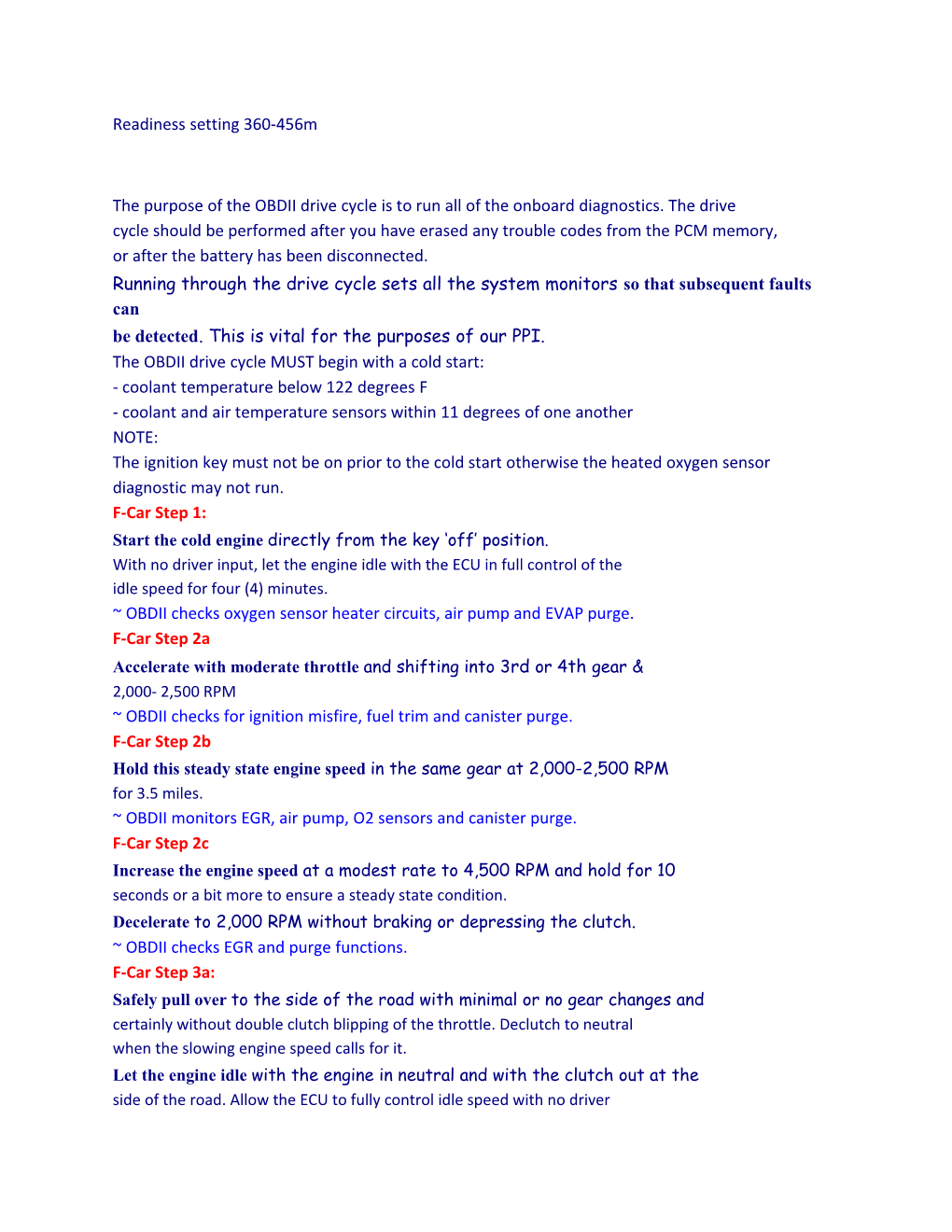Readiness setting 360-456m
The purpose of the OBDII drive cycle is to run all of the onboard diagnostics. The drive
cycle should be performed after you have erased any trouble codes from the PCM memory,
or after the battery has been disconnected.
Running through the drive cycle sets all the system monitors so that subsequent faults can
be detected. This is vital for the purposes of our PPI.
The OBDII drive cycle MUST begin with a cold start:
- coolant temperature below 122 degrees F
- coolant and air temperature sensors within 11 degrees of one another
NOTE:
The ignition key must not be on prior to the cold start otherwise the heated oxygen sensor
diagnostic may not run.
F-Car Step 1:
Start the cold engine directly from the key ‘off’ position.
With no driver input, let the engine idle with the ECU in full control of the
idle speed for four (4) minutes.
~ OBDII checks oxygen sensor heater circuits, air pump and EVAP purge.
F-Car Step 2a
Accelerate with moderate throttle and shifting into 3rd or 4th gear &
2,000- 2,500 RPM
~ OBDII checks for ignition misfire, fuel trim and canister purge.
F-Car Step 2b
Hold this steady state engine speed in the same gear at 2,000-2,500 RPM
for 3.5 miles.
~ OBDII monitors EGR, air pump, O2 sensors and canister purge.
F-Car Step 2c
Increase the engine speed at a modest rate to 4,500 RPM and hold for 10
seconds or a bit more to ensure a steady state condition.
Decelerate to 2,000 RPM without braking or depressing the clutch.
~ OBDII checks EGR and purge functions.
F-Car Step 3a:
Safely pull over to the side of the road with minimal or no gear changes and
certainly without double clutch blipping of the throttle. Declutch to neutral
when the slowing engine speed calls for it.
Let the engine idle with the engine in neutral and with the clutch out at the
side of the road. Allow the ECU to fully control idle speed with no driver
input.
For a full 5 minutes, allow the engine to idle in neutral with no driver input.
During this 5 minutes of idling, do not change the engine loading by switching
on any accessories (like the A/C).
F-Car Step 3b:
Switch the engine and key fully off after the 5 minute idle.
Keep the key in the off position for 15 to 20 seconds.
F-Car Step 4:
Restart the car and drive it at a moderate acceleration back up to 3rd or
4th in the 2,500 to 3,500 RPM range (i.e.: “normal driving”).
~ OBDII checks misfire, fuel trim and purge again.
Continue to drive for at least 10 minutes with the car under this steady
state condition (2,500 to 3,500 RPM).
~ OBDII monitors catalytic converter efficiency, misfire, EGR, fuel trim,
oxygen sensors and purge functions.
F-Car Step 5:
Safely pull over to the side of the road with minimal or no gear changes and
certainly without any double clutch blipping of the throttle. As appropriate,
keep the engine in gear as you de-accelerate.
~ OBDII makes a final check of EGR and canister purge.
Check readiness codes w/ OBDII scanner
